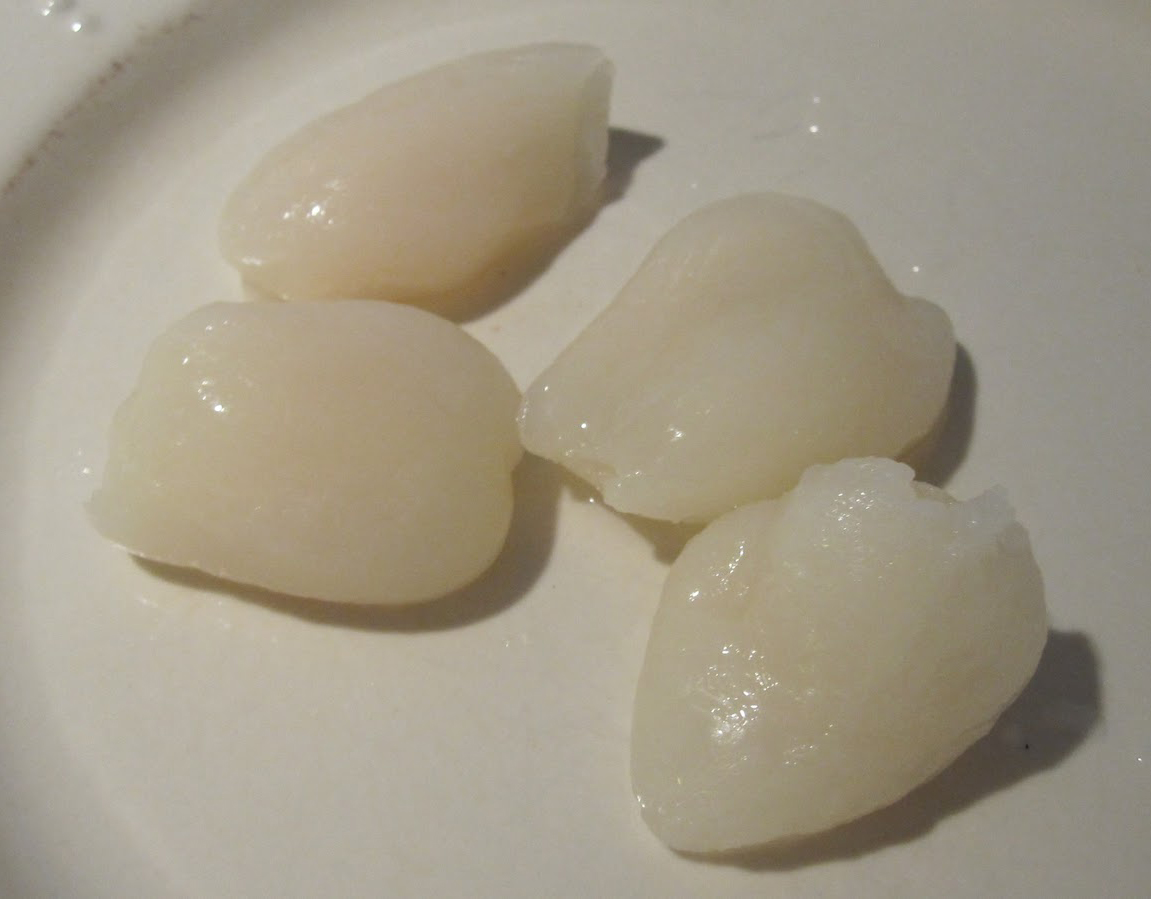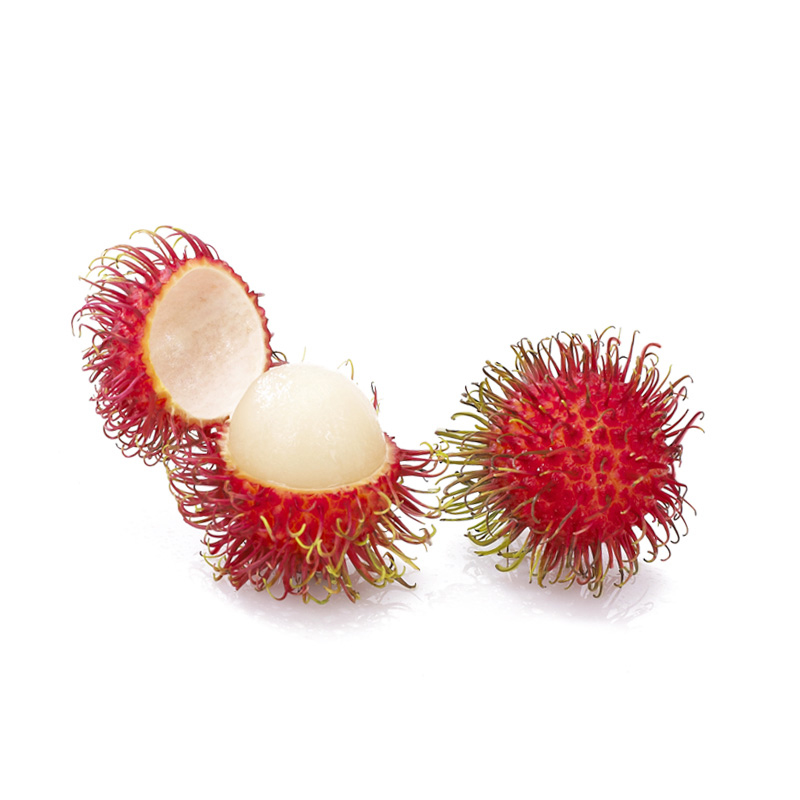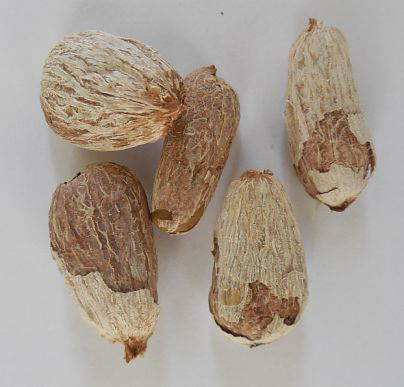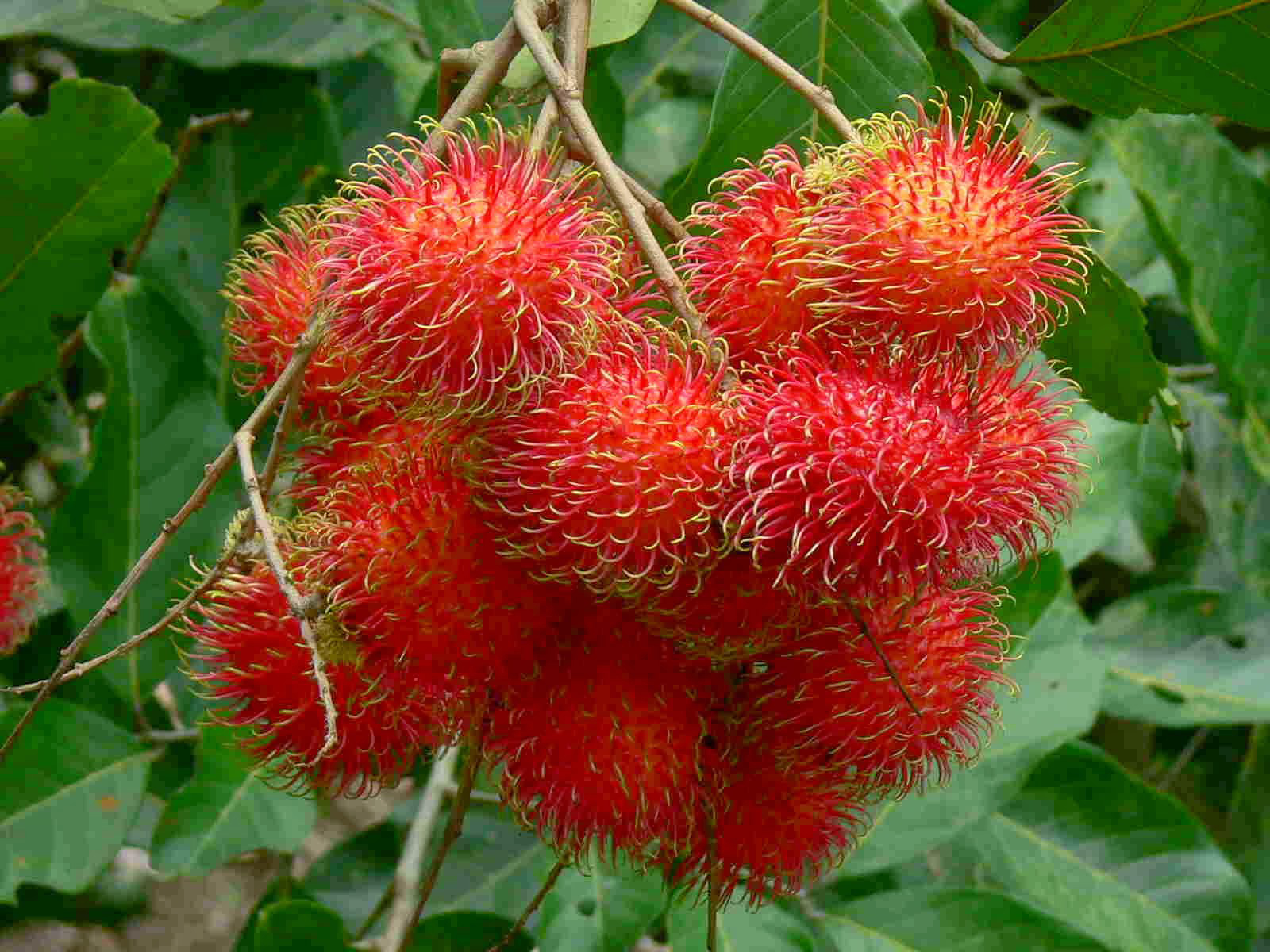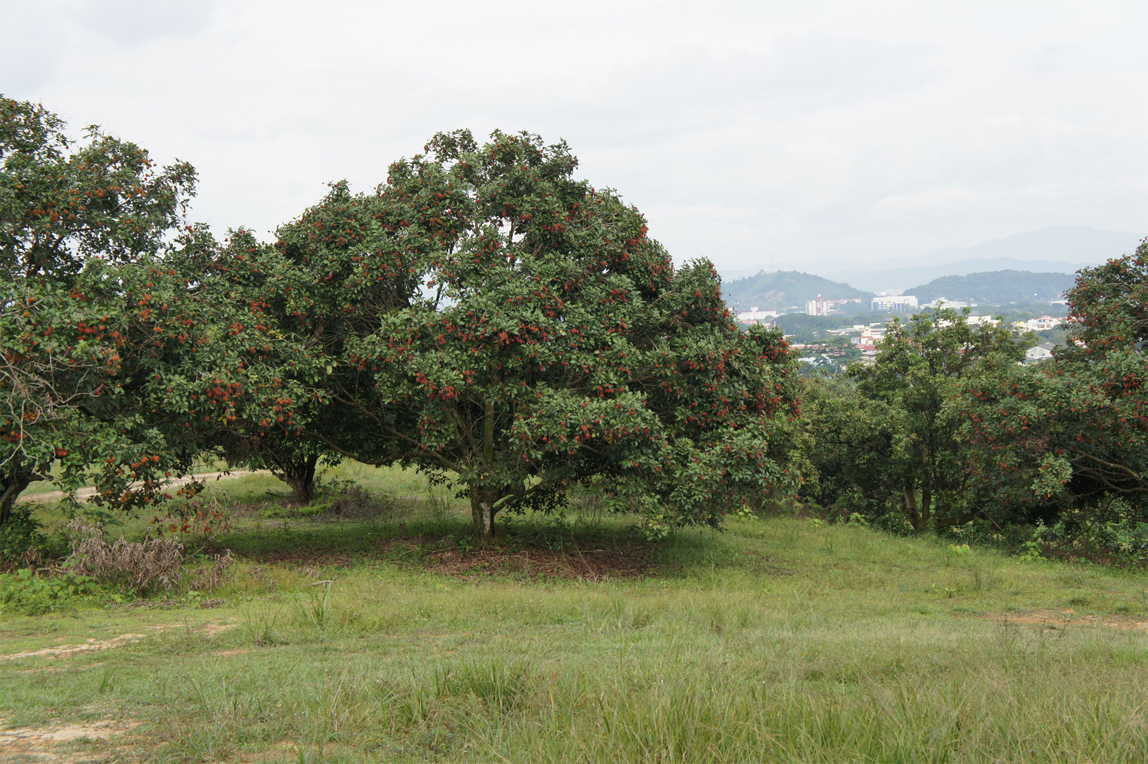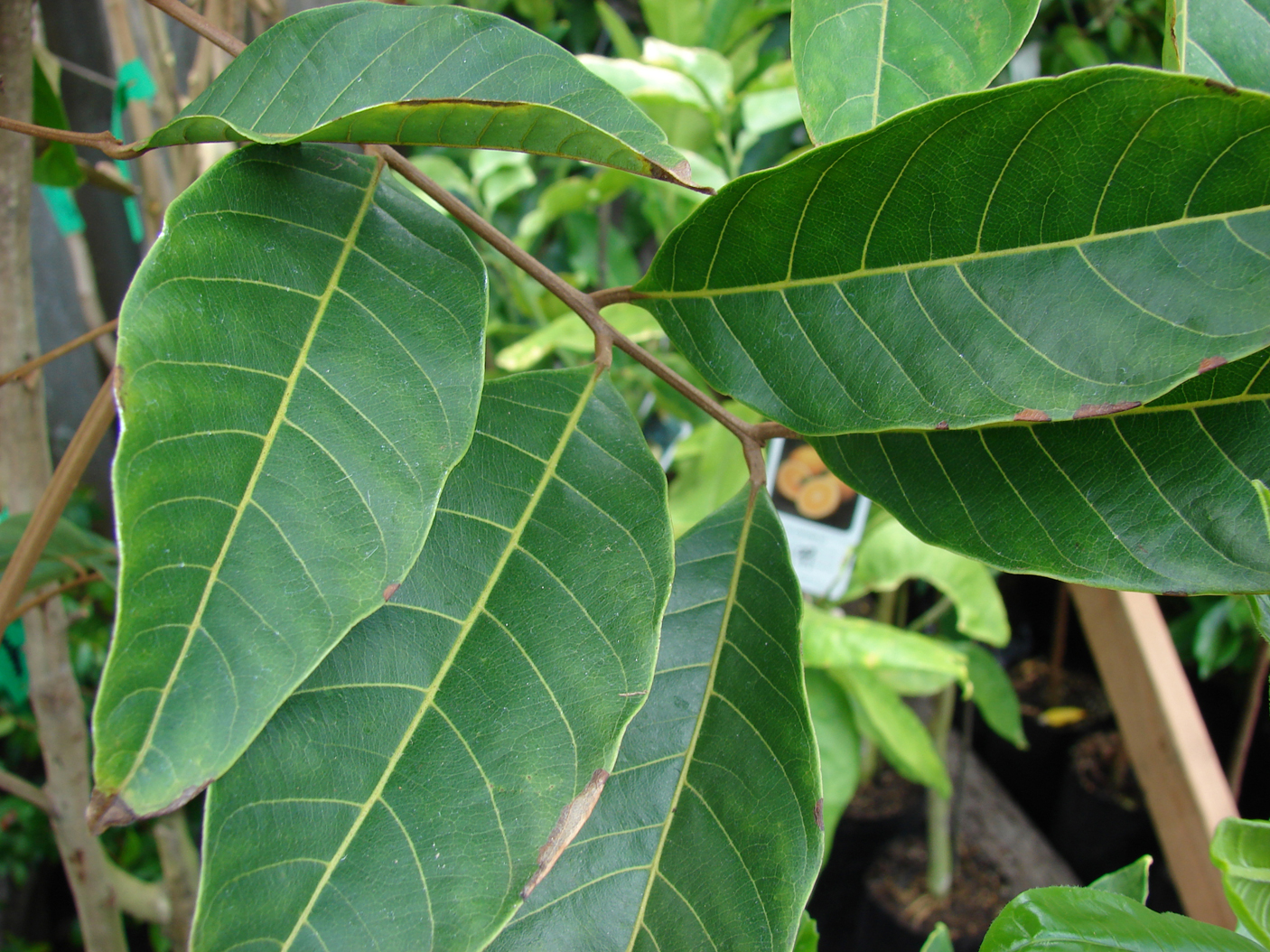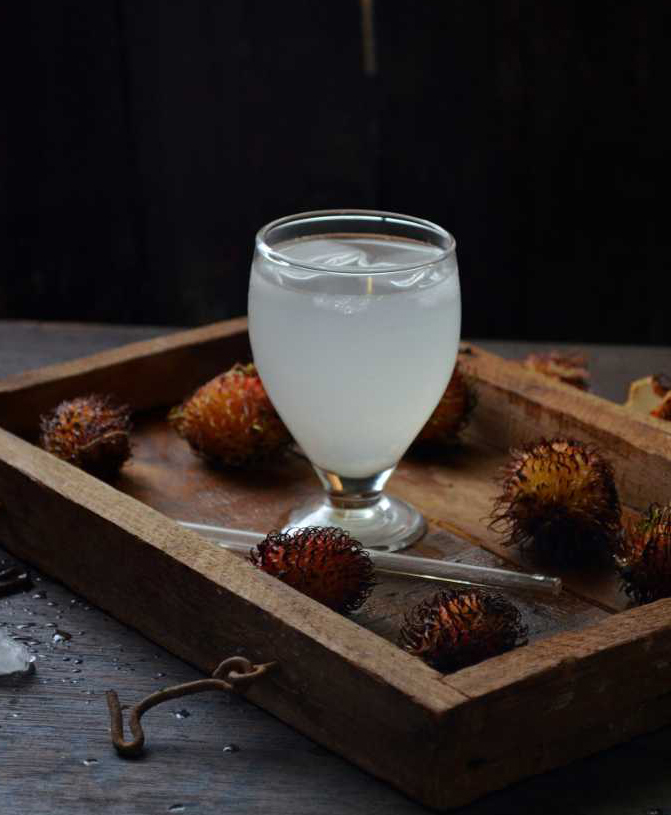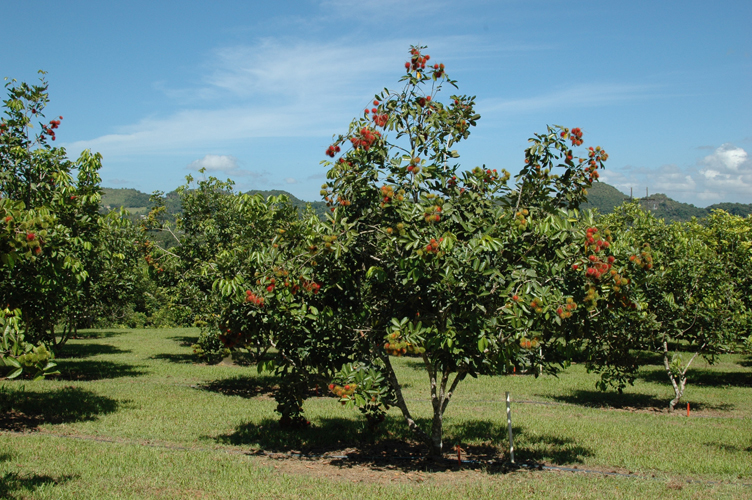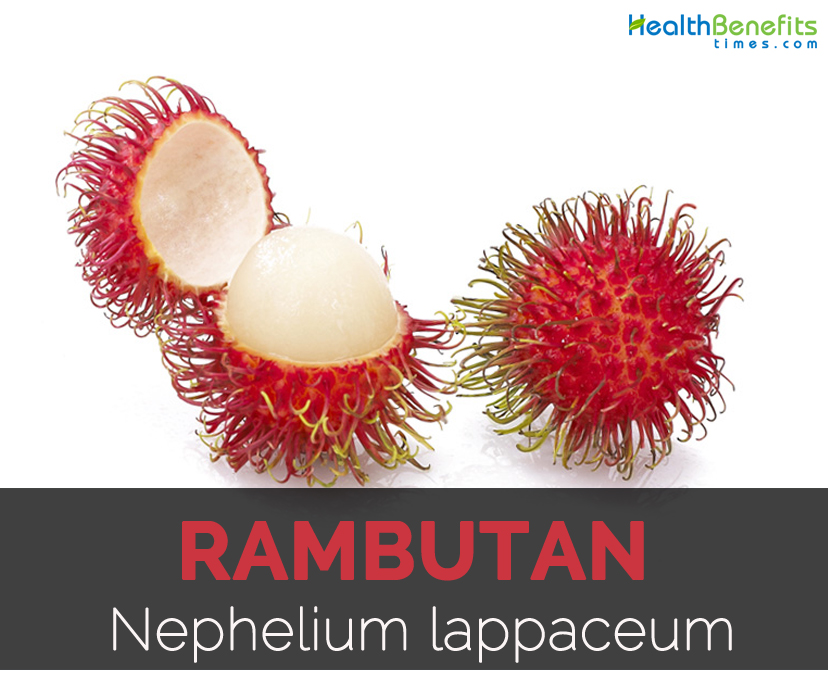 Native to West Malaysia, the name rambutan is derived from Malay word which means hairy. The outer part of the fruit is hairy and the flesh inside is tender and fleshy. It tastes sweet and sour like grape. Though it is imported in Southeast Asia, Rambutan is imported all around the world. Fruit resembles the appearance of lychees. Similar to lychees, it is found in bunches with stem sticking out of them. Rambutan could also have greenish yellow or orange exterior.
Native to West Malaysia, the name rambutan is derived from Malay word which means hairy. The outer part of the fruit is hairy and the flesh inside is tender and fleshy. It tastes sweet and sour like grape. Though it is imported in Southeast Asia, Rambutan is imported all around the world. Fruit resembles the appearance of lychees. Similar to lychees, it is found in bunches with stem sticking out of them. Rambutan could also have greenish yellow or orange exterior.
The tree of Rambutan is 15 to 25 meters tall which produces fruits twice every year. The fruit has the size golf ball which is covered with shell having reddish to orange spines appearing like hair. This covering could be peeled to expose pale white fruit inside. The flowers possess fairly sweet aroma which is white or green in color. An average tree produces from 5000 to 6000 fruits each year whereas some trees may produce 10000 fruits in a year.
Rambutan is consumed raw and is used in many Asian countries. When the fruit is young, the spines which cover the fruit are bright green which turns to reddish to orange color which signals that the fruit is ready for harvesting. This fruit is an excellent source of manganese along with potassium, sodium, zinc, iron, phosphorus, magnesium and calcium. In addition, there are high content of Vitamin C and Vitamin B in this small fruit. It contains few unique organic compounds including vanillin and cinnamic acid as well as antioxidants which promote overall health. It has low content of calories with small amounts of dietary fiber, protein and carbohydrates.
Rambutans are usually harvested at the peak of maturity. Harvesting stops further ripening of the fruit. Storage is quite a major problem for the fruit because, during storage, the fruit rapidly loses its quality in appearance, due to shriveling and browning of the rind. Additionally, longer storage also causes the fruit to soften and the pulp to become rather watery and leaky, which seriously affects the fruit quality and ultimately the market price and consumer acceptance. Standard storage practices need to be stringently followed in order to maintain freshness and high fruit quality.
History
Nephelium lappaceum has its origin in Southeast Asia, and is widely cultivated in Malaysia (80,000 tonnes), Indonesia (148,000 tonnes), Thailand (430,000 tonnes), and the Philippines (20,000 tonnes). To the people of Malaysia, Thailand, the Philippines, Vietnam, Borneo, and other countries of this region, the rambutan is a relatively common fruit. Thailand is a major producer and exporter of rambutan, where the ‘Rong-rien’ variety is the most popular variety commercially, with demand increasing annually.
Plant
Rambutan is an evergreen, medium sized and much branched tree which grows from 15 to 25 m tall having erect trunk of 40 to 60 cm diameter. The bark is dark brownish to grey. The twigs are pubescent and terete which becomes glabrescent. It bears alternate leaves which are pinnately compound. Petioles are 1 to 3.5 mm thick and 1.5 to 16 cm long. Leaflets are pale green, pubescent, soft, alternate to sub-opposite. Fruits are formed in loose clusters of 10 to 18. Fruit is a drupe having one ovules developed. It is green while young which turns into yellow and red. It is round to ovoid in shape measuring 3.5 to 4.5 cm wide and 4.5 to 6 cm long and weighs 20 to 60 g. Skin is leathery orange or yellow which is covered with fleshy pliable spines. Seeds are glossy brown, flattened oval measuring 1 to 1.3 cm.
Health Benefits of Rambutan
This fruit provides great amounts of natural sugars such as calcium, phosphorus, iron, copper, potassium, magnesium, manganese, Vitamin B3, A, C and Vitamin B9. Rambutan is a great source of minerals and vitamins that assist to strengthen bones, lose weight and also provide anti-parasitic properties. The juice of leaves promotes healthy scalp and seeds possess anti-diabetic properties. Seeds possess equal proportions of saturated and unsaturated fatty acids such as arachidic (34 percent) and oleic (42 percent) acids.
- Anti-viral activities
The conducted study shows that geraniin possess antiviral activities against DENV-2 by preventing mechanism of viral attachment. It shows effect through E protein during early stage of virus life cycle. It suppresses early viral gene transcription as well as replication. An exact mechanism through which geraniin inhibit DENV-2 gene transcription is unknown. In vivo experiments, determination of efficacy of geraniin for protection against DENV-2 challenge would be helpful as it could affirm capability of geraniin to be developed further as anti-dengue agent. (1)
- Anti-diabetic activity
Studies show that Rambutan peel phenolic extract displayed high antioxidant as well as antiglycation activities in vivo and in vitro. Further study assessed anti-diabetic activities of Rambutan peel phenolic extract in mouse model of Type II diabetes promoted by streptozotocin incorporated with high fat diet. The results show that Rambutan peel phenolic extract promoted body weight and lowered the fasting level of blood glucose of the diabetic mice. The extract lowered the serum levels of total cholesterol, creatinine, and triglyceride and glycated serum protein in diabetic mice. Rambutan peel phenolic extract recovered glycogen content in mice liver which promoted activity of glutathione peroxidase and superoxide dismutase and lowered lipid perioxidation in diabetic mice. Rambutan peel phenolic extract protected tissue structure of liver, pancreas and kidney. Moreover, Rambutan peel phenolic extract lowered mesangial index and inhibited expression of TGF-β in kidney of diabetic mice. (2)
- Prevent coronary heart disease
Coronary heart is the deposition of fat accumulated in cells lining the walls of coronary artery and block flow of blood. This disease makes the arteries in heart narrow. When it gets worsened, the oxygen supply blood to heart can be lowered through blood stream and causes damage to heart. Vitamin B3 has the ability of converting fats, carbohydrates and proteins into energy. These fats prevent excess cholesterol in the body.
- Source of Vitamin C
Vitamin C is an essential antioxidant which helps in strengthening immune system of the body to counteract free and harmful radicals. It supports in lowering inflammation of cell and also promotes absorption of iron which is vital for good blood health. Besides collagen forming compounds, Vitamin C is essential to repair and build skin tissue, joints and bones.
- Strengthen bones
Intake of Rambutan provides adequate amounts of iron, calcium and phosphorus to the body. The body utilizes it when these elements are broken down for repairing and forming strong bones and promote stable growth. It lowers the chances of bone diseases and fractures.
- Sperm health
High intake of Vitamin C is associated with healthy development of sperms. It might be possible that deficiency of Vitamin C in males might be the reason for conceiving children. The daily intake of 500 milligrams of Vitamin C is recommended for good sperm health. Consume Rambutan fruit which provides healthy amounts of Vitamin C that assist to enhance quantity and quality of sperm.
- Normalizes blood pressure
Hypertension as do not show any symptoms, it is known as silent killer. It causes damage in blood vessels that could result to heart disease, stroke, heart disease and other serious health ailments. Being overweight or obese also increases the chances of developing high blood pressure. The fruit have low saturated fat and calories which is suitable for hypertension patients.
- Antioxidant activity
Antioxidants promote the defenses of body against harmful compounds known as free radicals. Pollution such as toxins, smog, and cigarette smoke and sun rays creates free radicals. Moreover, the skin of the fruit also possesses antioxidants which could be boiled in water and could be ingested to reap these health benefits. The study shows that seeds, pulp and skin possess strong polyphenolic compounds known as flavonoids. Flavonoids are called as pigments for flower coloration which produce blue/red or yellow pigmentation in plants.
- Promotes skin heath
Seeds help to enhance appearance and health of skin. Make the paste of the seeds and apply it to the skin to obtain clearer as well as even complexion. Use the paste of the seeds daily to smoothen and soften the skin and also improve the texture of the skin. Rambutan also hydrates the skin. This fruit contains manganese and Vitamin C which supports production of collagen and acts as antioxidant that counteracts the damage made by free radicals. It makes the skin look young and healthy for longer time period.
- Healthy hair
Rambutan possesses an antibacterial property which is helpful for treating dandruff and other scalp problems such as itching. It contains Vitamin C which helps to nourish the scalp as well as hair. Rambutan has copper which is helpful in treating hair loss, intensifies hair color and prevents premature graying. It contains protein which assists to strengthen hair roots. Vitamin C in Rambutan adds shine to the hair. Apply Rambutan juice to the hair and let it remain for about 15 minutes before shampooing.
Origin and distribution
It is just a well-known thought that rambutan are indigenous to Malaysia and Indonesia. The initial record of rambutan trees reveal that they were grown by the Malayan jungle people about their short-term settlements, an exercise followed to date. Rambutan trees are today discovered expanding naturally in Southern China, the Indochina region as well as Southeast Asia. With ever increasing popularity among non-Asians and growing interest in rambutan globally, the fruit is at present regarded as an essential agricultural produce. It really is developed in a commercial sense in Indonesia, Malaysia, Philippines, Thailand, Brunei Darussalam, Sri Lanka, Australia, Hawaii, Vietnam and also Central America. Even just in 1981, rambutan were cultivated commercially on approximately 700 ha of land in Singapore. Fast urbanization meant rambutan plantations shall no longer be present in Singapore. To satisfy the requirements of the individuals, Singapore has remained the biggest importer of rambutan on the planet, comprising a lot more than 60% of world imports.
Types of Rambutan
• Lebakbooloos
• Seematjan
• Seenjonja
• Maharlika
• Sectangkooweh
• Seelengkeng
• Seekonto
Traditional uses
- Pulp is used in folkloric medicine for fevers.
- Fruit is useful to provide relief from dysentery and diarrhea.
- Leaves are used as poultice on temples for alleviating headache.
- For thrush, use the decoction made from bark.
- In Malaysia, root decoction is used to treat fever.
- In China, fruit is used for severe dysentery and as a warm carminative in cold dyspepsia.
- Boil the peel and drink the liquid to cure dysentery and fevers.
Precautions
- It contains fructose which promotes resistance of insulin that could worsen diabetes as it could cause spike in level of blood sugar.
- It could be harmful for blood pressure patients because the sugar turns into alcohol in ripened fruit.
- Avoid consuming seeds as it could be fatal.
How to Eat
- The fruits could be canned, frozen and thawed.
- Rambutan could be processed into jellies, jams, mix fruit cordials, fruit rolls and fruit juices.
- Roasted seeds are consumed.
- Add it to fruit salads.
- It could be used in smoothies, desserts, cocktails, jams, yogurt, chutney, jellies, salsa, soup and syrups.
Storage
The short shelf life and perishability of Rambutan are a major issue which limits the export of this fruit to the world market. Salicylic acid and lukewarm treatment increase the shelf life, but still there is a need to develop new methods which can facilitate a longer storage time, so that the fruit can be exported to distant countries without damaging the taste, flavor, and quality of the fruit.
References:
https://www.itis.gov/servlet/SingleRpt/SingleRpt?search_topic=TSN&search_value=506073#null
http://www.stylecraze.com/articles/amazing-health-benefits-of-rambutan/#gref
https://www.mnn.com/food/healthy-eating/photos/15-fruits-youve-probably-never-heard-of/rambutan
https://caloriebee.com/nutrition/Rambutan-Fruit
https://www.cabi.org/isc/datasheet/35990
https://www.curejoy.com/content/health-benefits-of-rambutan-fruit/
http://www.yourhealthremedy.com/medicinal-plants/rambutan-fruit/



